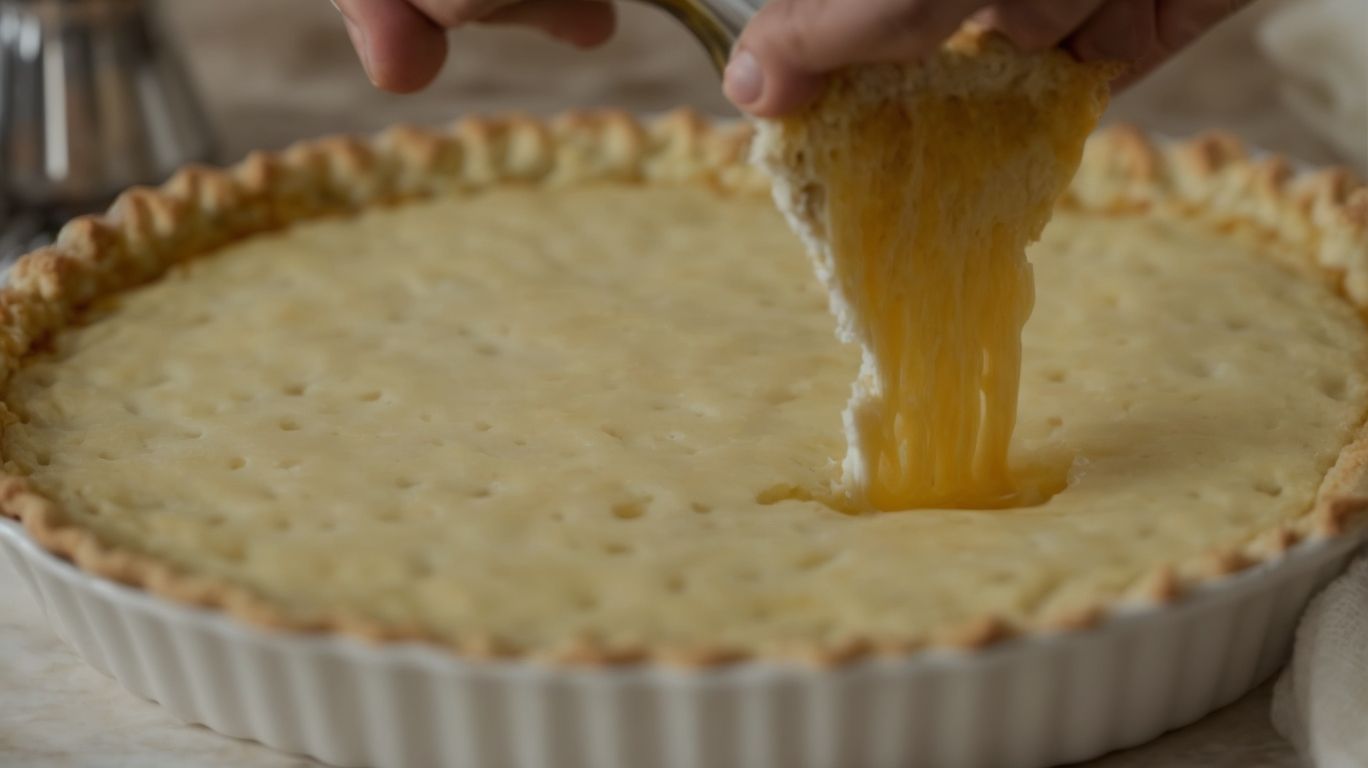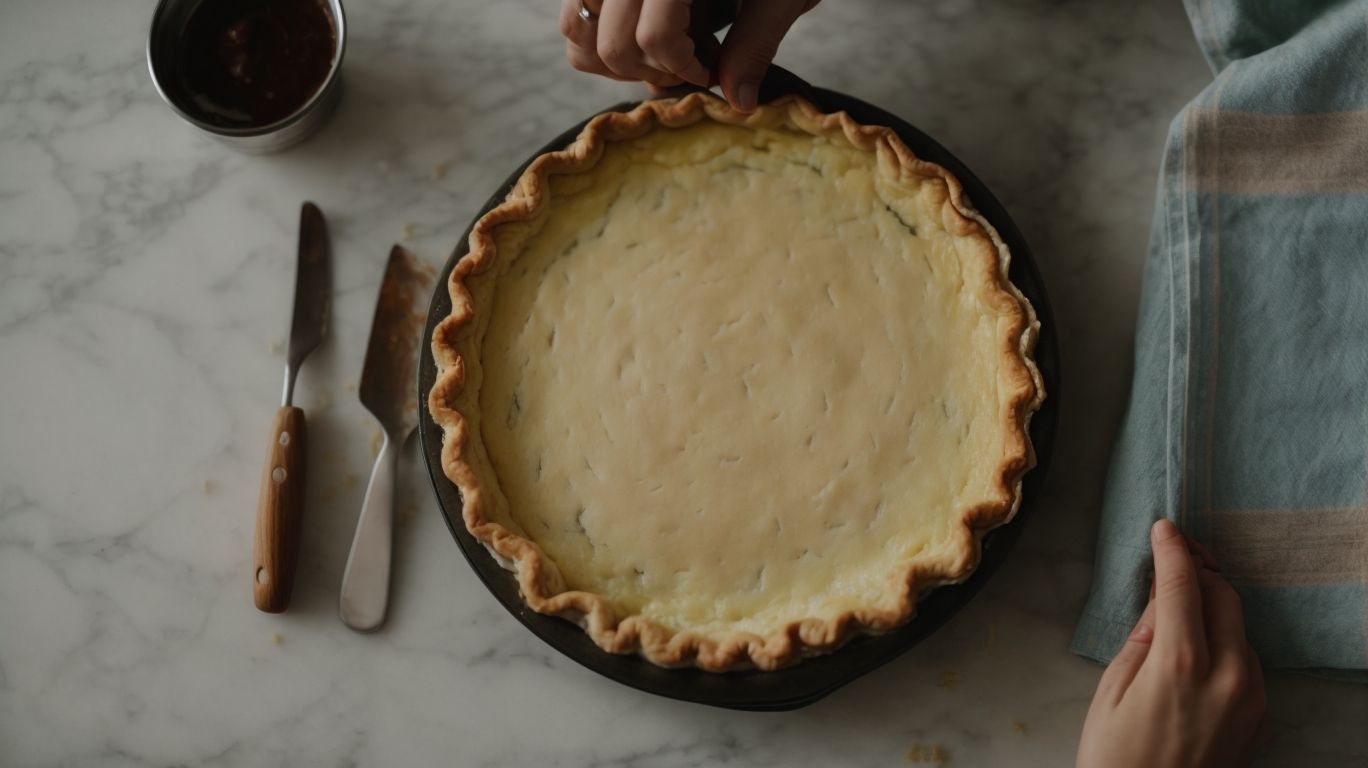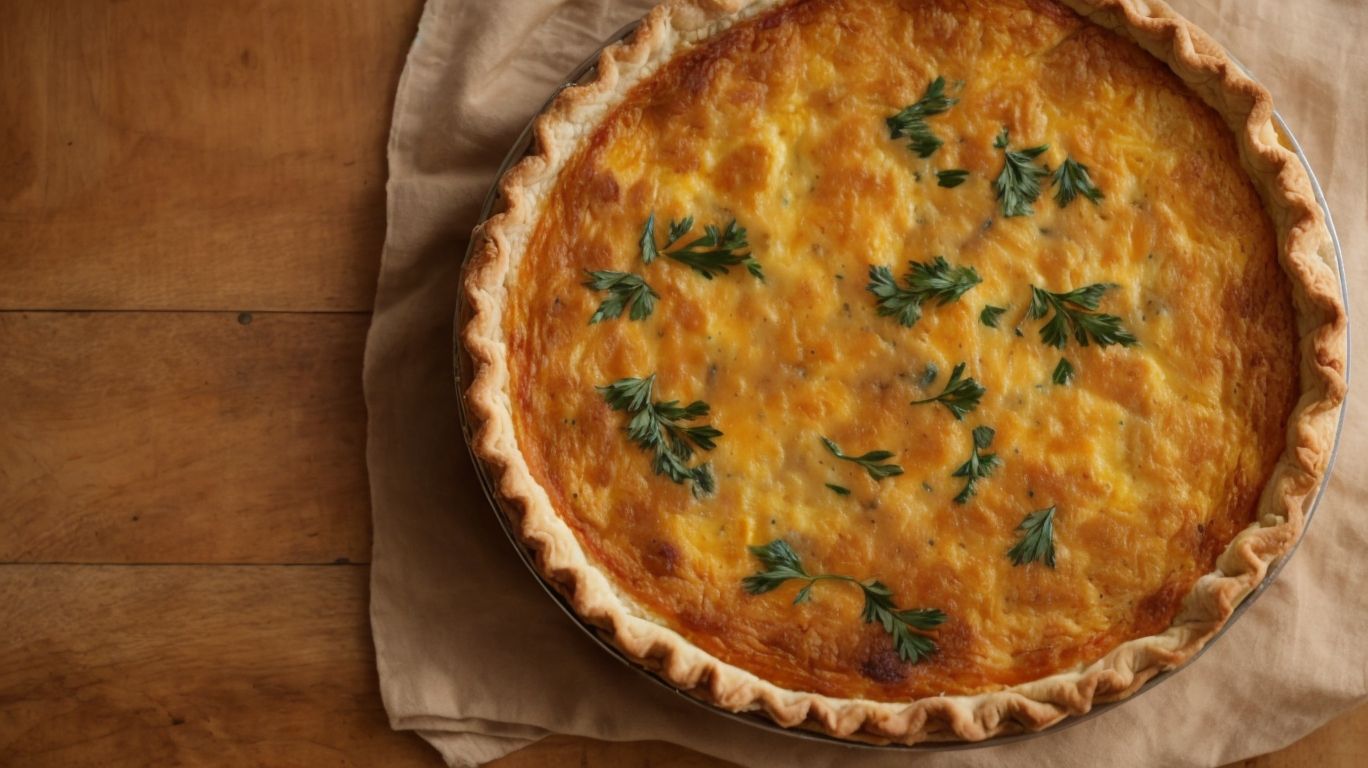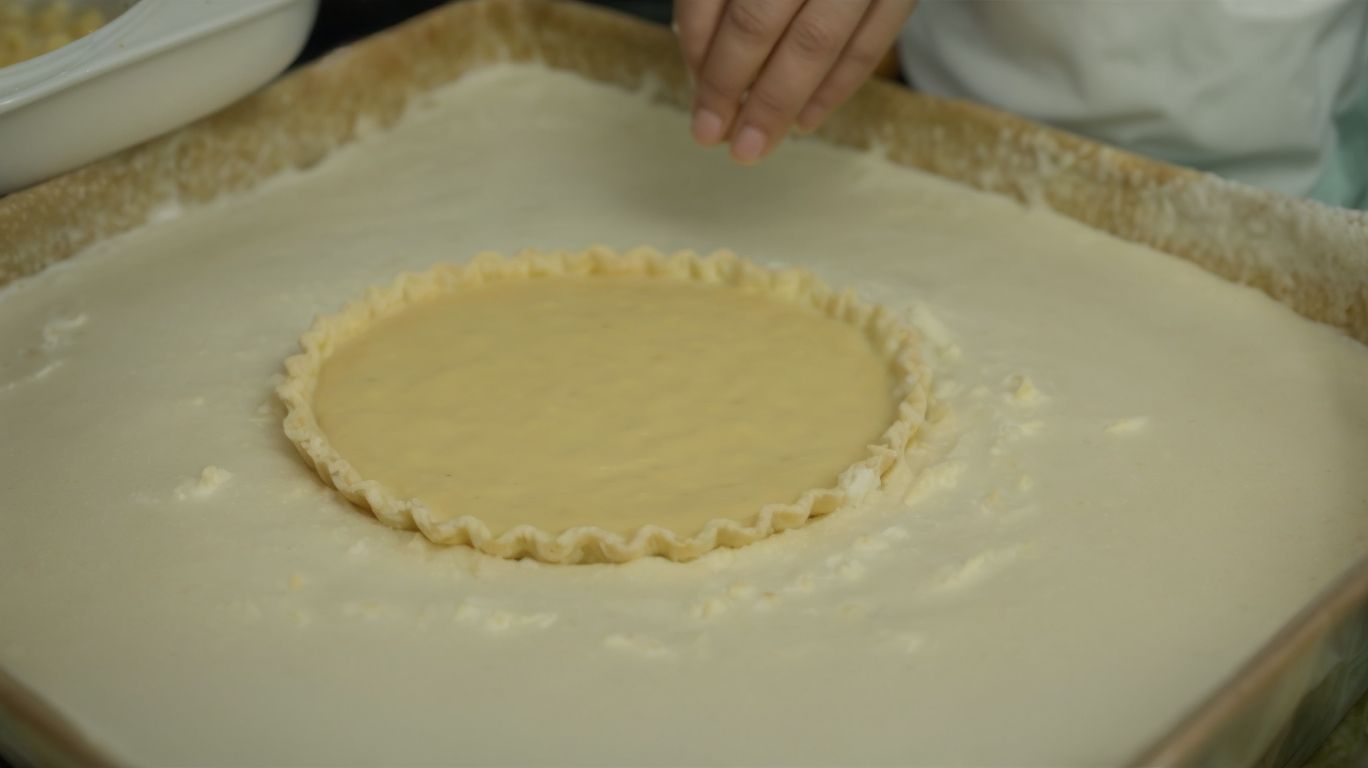How to Bake Quiche With Frozen Pie Crust?
Looking to elevate your brunch game with a delicious and savory dish? Quiche is the answer!
We will explore what quiche is, what frozen pie crust is, and why using frozen pie crust for quiche is a game-changer. Dive into the ingredients needed for this delectable dish and follow a step-by-step guide on how to make quiche with frozen pie crust.
Get ready to impress your friends and family with this mouthwatering recipe and some expert tips on baking the perfect quiche!
Key Takeaways:
What is Quiche?
Quiche is a classic French dish known for its savory custard filling baked in a pie crust.
Originating in the Lorraine region of France, quiche is believed to have its roots in German cuisine, where a similar dish called ‘kuchen’ meaning cake was popular. The key components of quiche are eggs mixed with cream, various cheeses, meats, and vegetables, all poured into a flaky pastry crust. The most common variation is Quiche Lorraine, consisting of bacon and cheese in the filling, but countless adaptations exist globally, such as mushroom quiche, spinach quiche, and Mediterranean quiche with ingredients like feta, olives, and sun-dried tomatoes.
What is Frozen Pie Crust?

Credits: Poormet.Com – Wayne Scott
A frozen pie crust is a convenient, pre-made pastry shell that eliminates the need for making dough from scratch.
Using a frozen pie crust not only saves time but also ensures a consistent and flaky base for your pies. To use it, simply thaw the crust as per the package instructions, and you’re ready to roll. Place the crust on a baking sheet, fill it with your favorite pie filling, and bake as directed. Whether you’re baking a classic apple pie or a savory quiche, the frozen pie crust guarantees a delicious result every time.
Why Use Frozen Pie Crust for Quiche?
Using a frozen pie crust for quiche saves time and effort while ensuring a consistent texture and flavor for the final dish.
One of the key advantages of opting for a frozen pie crust is the convenience it offers. With a ready-made base, you can skip the time-consuming process of making the crust from scratch, allowing you to focus on preparing the delectable filling instead.
Frozen pie crusts are designed to maintain their structure during baking, resulting in a flaky and crisp texture that complements the creamy quiche filling perfectly. This ensures that your quiche turns out perfectly baked every time, eliminating the risk of a soggy or undercooked crust.
Another benefit is the flavor retention offered by frozen pie crusts. The pre-made crust acts as a barrier, preventing the filling from seeping into the pastry and maintaining its distinct flavors and textures.
In terms of meal prep efficiency, utilizing a frozen pie crust can significantly reduce the overall preparation time. Whether you are hosting a brunch or preparing a quick weeknight dinner, the convenience of a frozen crust allows you to whip up a delicious quiche in no time, making it a go-to option for hassle-free meal solutions.
What are the Ingredients for Quiche with Frozen Pie Crust?
The key ingredients for quiche with a frozen pie crust include bacon, cheese, cream, half-and-half, and a flavorful filling of your choice.
When making a quiche with a frozen pie crust, bacon adds a rich and savory flavor profile, while cheese provides a gooey and melted texture. Cream and half-and-half contribute to the creamy consistency of the *filling*, ensuring a luscious and indulgent bite with every spoonful. It’s crucial to create a well-balanced filling that complements the other ingredients, combining various flavors and textures harmoniously. The baking process further enhances the flavors, melding them together to create a mouthwatering dish that is perfect for any meal of the day.
Frozen Pie Crust
The frozen pie crust serves as the foundation for the quiche, providing a crispy, buttery base that elevates the overall texture and taste of the dish.
When baking the quiche, the frozen pie crust helps maintain the structural integrity of the dish, ensuring a perfect golden-brown crust that contrasts beautifully with the creamy egg custard.
It’s crucial to store the remaining pie crust appropriately for future use. Refrigerating the unused portion preserves its freshness and prevents it from becoming soggy or losing its flakiness.
This versatile ingredient allows for creative variations in quiche recipes, enabling you to experiment with different fillings, from classic combinations like spinach and feta to more unconventional options such as smoked salmon and dill.
Eggs
Eggs play a crucial role in quiche recipes, acting as the main component of the custard that gives quiche its signature texture and consistency.
Without eggs, the custard filling of a quiche would lack the richness and binding properties that make it the creamy base we all love. When combined with cream or milk, eggs create a velvety texture that holds all the other ingredients together in perfect harmony.
A popular example of a classic quiche using this custard base is the famous Quiche Lorraine, a French dish filled with bacon (lardons) and cheese. The combination of eggs, cream, and these savory ingredients creates a delightful explosion of flavors that have made this recipe a timeless favorite.
Milk
Milk, half-and-half, or heavy cream are commonly used in quiche recipes to add richness and creaminess to the custard filling.
Each of these dairy products brings its own unique qualities to the dish. Milk provides a light and subtle creaminess, ideal for a more delicate flavor profile. On the other hand, half-and-half offers a richer texture and slightly more indulgent taste compared to milk. Heavy cream, with its high fat content, results in an exceptionally velvety and luscious custard, perfect for those seeking a truly decadent quiche experience.
Cheese
Cheese is a versatile ingredient in quiche, with options ranging from Gruyère and Parmesan to Swiss and sharp cheddar, adding depth of flavor and richness to the dish.
In terms of creating the perfect quiche, selecting the right cheese plays a crucial role in determining the overall taste and texture.
- Varieties like Gruyère, with its nutty and slightly sweet flavor, add a sophisticated touch to the dish.
- Parmesan, known for its sharp and salty notes, can elevate the savory profile of the quiche.
- Swiss cheese brings a creamy texture and a mild, nutty taste that pairs beautifully with various ingredients.
- And let’s not forget about the bold and tangy kick that sharp cheddar cheese adds to the quiche, creating a delightful contrast of flavors.
Vegetables or Meat (Optional)
Plus the base ingredients, quiche allows for the incorporation of vegetables such as shallots, bacon, or other meats to enhance the savory profile of the dish.
When considering additional elements to elevate the taste of your quiche, bacon stands out as a popular choice due to its rich, smoky flavor that complements the creamy texture of the custard perfectly. The salty notes from the bacon can add depth to the overall taste, creating a well-balanced dish that delights the palate. Alongside bacon, the inclusion of shallots brings a subtle sweetness and a mild onion flavor that enhances the savory notes of the quiche.
How to Make Quiche with Frozen Pie Crust?

Credits: Poormet.Com – Edward Perez
To make quiche with a frozen pie crust, you need to preheat the oven, prepare the fillings, and follow the baking instructions for a golden, crispy finish.
Start by preheating your oven to the temperature specified in your quiche recipe, typically around 375°F.
While the oven is warming up, prepare your quiche filling. This can include a variety of ingredients such as eggs, cream, vegetables, meat, and cheese. Be creative and customize the flavors to your liking!
Once your filling is ready, take the frozen pie crust out of the freezer and let it thaw slightly while you prepare the crust with a light egg wash or pricking holes with a fork.
Next, carefully pour the filling into the pie crust, making sure not to overfill to prevent spillage during baking.
Preheat the Oven
The first step in making quiche is to preheat the oven to ensure that the dish bakes evenly and attains a golden brown crust.
Preheating the oven plays a crucial role in the baking process as it allows the quiche to start cooking immediately at the right temperature, promoting even heat distribution. Setting the oven temperature to around 375°F (190°C) is generally recommended for most quiche recipes. This moderate heat helps the custard to set properly without curdling while ensuring the crust bakes to perfection.
The baking time for a quiche may vary depending on the size and ingredients, but a typical guideline is around 35-45 minutes, or until the top of the quiche turns a rich golden brown. This visual cue indicates that the quiche is fully cooked and ready to be enjoyed.
Prepare the Frozen Pie Crust
Next, prepare the frozen pie crust by thawing it slightly and placing it in a baking sheet as per the package instructions before baking.
Thawing the frozen pie crust can be done by letting it sit at room temperature for about 15-20 minutes, making it easier to work with while still keeping it cool. Once partially thawed, gently unfold the crust and place it in a pie dish or on a baking sheet, ensuring it fits properly without any folds or creases. Following the package guidelines is crucial as different brands may have slightly varying instructions for pre-baking procedures.
Make the Filling
Prepare the filling by combining savory ingredients like cheese, vegetables, and meats, creating a flavorful mixture that will bake beautifully into the quiche.
When crafting the perfect quiche filling, it’s crucial to strike the right balance between the richness of the cheese and the freshness of the vegetables. Opt for a combination of sharp Cheddar and creamy Gruyere to bring depth of flavor, while adding sautéed mushrooms, spinach, or caramelized onions for a burst of earthy sweetness.
Your choice of meats, whether crispy bacon, diced ham, or smoked salmon, can further elevate the taste profile. To ensure a silky, moist texture in your quiche, beat together eggs and heavy cream until well combined, then pour the mixture over the prepared filling before baking.
Bake the Quiche
Bake the quiche in the preheated oven until the custard is set and the top is golden brown, following the specific instructions for your chosen recipe.
Proper heat distribution is crucial for ensuring that the quiche bakes evenly. Placing the quiche on the center rack of the oven helps to achieve this, allowing the heat to circulate around the dish uniformly. To achieve that desirable golden brown finish on top, consider brushing the surface with a light egg wash before baking. This simple step adds a beautiful sheen and color to the quiche. Remember, following the instructions in your recipe to the letter is paramount to achieve optimal results. Any deviations could affect the final texture and flavor of your quiche.
Tips for Baking the Perfect Quiche with Frozen Pie Crust
Achieving the perfect quiche involves techniques like blind baking the crust, using room temperature ingredients, experimenting with fillings, and allowing the quiche to cool before serving.
One of the key steps in perfecting your quiche is blind baking the crust. This ensures a crisp and flaky base that won’t become soggy once the filling is added.
In terms of ingredients, it’s crucial to use them at room temperature as this helps them blend together seamlessly, resulting in a smoother and more uniform texture for your quiche.
To elevate your quiche game, don’t shy away from experimenting with various fillings such as spinach and feta, caramelized onions, or sun-dried tomatoes for a unique twist.
Allowing your quiche to cool properly before slicing and serving will help it set and develop its flavors, making each bite a delightful experience.
Blind Bake the Crust
To prevent a soggy bottom, blind bake the crust by lining it with parchment paper and weights before baking the quiche filling for a better texture.
Blind baking is a crucial step in quiche preparation that ensures the crust stays crisp and flaky, providing a delicious contrast to the creamy filling.
- To start, roll out your pastry dough and carefully fit it into the pie dish, making sure there are no air bubbles.
- Next, line the crust with parchment paper or foil, and then add pie weights or dry beans to weigh it down during baking. This helps keep the crust flat and prevents it from puffing up or shrinking.
Bake the crust in a preheated oven for about 15-20 minutes to set it before removing the weights and parchment paper. This initial baking helps create a barrier that seals the crust and maintains its structure when the filling is added. The end result is a perfectly cooked crust with a delightful flakiness and crunch that complements the savory or sweet filling of your quiche.
Use Room Temperature Ingredients
Incorporating room temperature ingredients into the custard mixture ensures even baking and proper setting of the quiche during the baking process.
When all ingredients are at room temperature, particularly the custard, they blend together seamlessly, resulting in a smoother texture in the baked quiche. A cold custard can shock the other ingredients, leading to a lumpy mixture and uneven baking. The consistency of the custard plays a crucial role in the final outcome of the quiche, affecting both its taste and appearance. Ensuring the custard is at the right temperature before baking is key to achieving a delicious, perfectly baked quiche.
Experiment with Different Fillings
Get creative with quiche fillings by experimenting with savory ingredients, exploring recipe variations, and customizing the dish to suit your taste preferences.
In terms of savory additions, the possibilities are endless. Consider incorporating ingredients such as sun-dried tomatoes, spinach, mushrooms, or caramelized onions for depth of flavor. Experiment with different cheeses like Gruyère, feta, or goat cheese to enhance the richness of your quiche. Don’t shy away from herbs and spices; a sprinkle of fresh thyme, a pinch of smoked paprika, or a hint of cayenne can elevate the taste profile.
To further enhance your quiche, think about tweaking the base recipe. Try a gluten-free crust using almond flour or swap traditional heavy cream for a lighter alternative like half-and-half. Balancing flavors is key, so play around with the ratios of ingredients to find the perfect combination for your palate.
Let the Quiche Cool Before Serving
Allow the quiche to cool on a wire rack before serving to ensure it reaches the ideal serving temperature and texture for a delightful culinary experience.
By letting the quiche cool on a wire rack, you are allowing air to circulate around the dish evenly, preventing condensation that could lead to a soggy bottom. This will help maintain the crispness of the crust and preserve the integrity of the filling.
Serving the quiche at room temperature enhances the flavors and textures, allowing the creamy custard to set beautifully and the ingredients to meld harmoniously. This brings out the full depth of flavors and aromas, creating a more satisfying dining experience.
Conclusion

Credits: Poormet.Com – Tyler Walker
In conclusion, quiche offers a delicious and versatile meal option that can be baked, stored, and frozen for convenient enjoyment at any time.
What makes quiche so appealing is its ability to accommodate a wide variety of ingredients, from vegetables and cheese to meats and seafood, providing a flavorful experience for every palate. This savory pastry dish is not only ideal for breakfast or brunch but can also serve as a quick and satisfying meal at any time of the day.
The convenience of preparing quiche ahead of time makes it a perfect choice for busy individuals; simply bake a large batch, portion it, and store in the refrigerator or freezer for later consumption. Its reheatability makes it an excellent on-the-go meal option, whether you’re heading to work, a picnic, or on a road trip.
Frequently Asked Questions
What is the best type of frozen pie crust to use for baking quiche?
The best type of frozen pie crust to use for baking quiche is a deep-dish crust, as it provides enough room for the filling and prevents overflow.
Can I bake a quiche directly in a frozen pie crust?
Yes, you can bake a quiche directly in a frozen pie crust. Just be sure to thaw the crust for a few minutes before adding the filling, to prevent the crust from cracking.
Should I pre-bake the frozen pie crust before adding the quiche filling?
It is not necessary to pre-bake the frozen pie crust before adding the quiche filling. However, if you prefer a crispier crust, you can pre-bake it for 10-15 minutes before adding the filling.
How can I prevent my quiche from becoming soggy when using a frozen pie crust?
To prevent your quiche from becoming soggy, you can brush the crust with an egg wash before adding the filling. This will create a barrier between the crust and the filling, keeping it crispy.
Can I freeze a quiche made with a frozen pie crust?
Yes, you can freeze a quiche made with a frozen pie crust. Before baking, wrap the quiche tightly in plastic wrap and then aluminum foil. When ready to bake, thaw in the refrigerator overnight before baking as directed.
How do I know when a quiche with frozen pie crust is fully cooked?
To ensure that your quiche is fully cooked, insert a knife into the center of the quiche. If it comes out clean, then the quiche is cooked. The internal temperature of the quiche should also reach 160°F.

